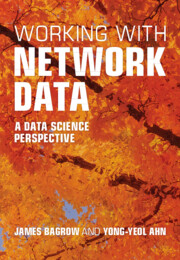Book contents
- Frontmatter
- Contents
- Preface
- Part I Background
- Part II Applications, tools, and tasks
- Chapter 5 The life cycle of a network study
- Chapter 6 Gathering data
- Chapter 7 Extracting networks from data — the “upstream task”
- Chapter 8 Implementation: storing and manipulating network data
- Chapter 9 Incorporating node and edge attributes
- Chapter 10 Awful errors and how to amend them
- Chapter 11 Explore and explain: statistics for network data
- Chapter 12 Understanding network structure and organization
- Chapter 13 Visualizing networks
- Chapter 14 Summarizing and comparing networks
- Chapter 15 Dynamics and dynamic networks
- Chapter 16 Machine learning
- Interlude — Good practices for scientific computing
- Part III Fundamentals
- Conclusion
- Bibliography
- Index
Chapter 14 - Summarizing and comparing networks
from Part II - Applications, tools, and tasks
Published online by Cambridge University Press: 06 June 2024
- Frontmatter
- Contents
- Preface
- Part I Background
- Part II Applications, tools, and tasks
- Chapter 5 The life cycle of a network study
- Chapter 6 Gathering data
- Chapter 7 Extracting networks from data — the “upstream task”
- Chapter 8 Implementation: storing and manipulating network data
- Chapter 9 Incorporating node and edge attributes
- Chapter 10 Awful errors and how to amend them
- Chapter 11 Explore and explain: statistics for network data
- Chapter 12 Understanding network structure and organization
- Chapter 13 Visualizing networks
- Chapter 14 Summarizing and comparing networks
- Chapter 15 Dynamics and dynamic networks
- Chapter 16 Machine learning
- Interlude — Good practices for scientific computing
- Part III Fundamentals
- Conclusion
- Bibliography
- Index
Summary
Realistic networks are rich in information. Often too rich for all that information to be easily conveyed. Summarizing the network then becomes useful, often necessary, for communication and understanding but, being wary, of course, that a summary necessarily loses information about the network. Further, networks often do not exist in isolation. Multiple networks may arise from a given dataset or multiple datasets may each give rise to different views of the same network. In such cases and more, researchers need tools and techniques to compare and contrast those networks. In this chapter, In this chapter, well show you how to summarize a network, using statistics, visualizations, and even other networks. From these summaries we then describe ways to compare networks, defining a distance between networks for example. Comparing multiple networks using the techniques we describe can help researchers choose the best data processing options and unearth intriguing similarities and differences between networks in diverse fields.
Keywords
- Type
- Chapter
- Information
- Working with Network DataA Data Science Perspective, pp. 223 - 234Publisher: Cambridge University PressPrint publication year: 2024

